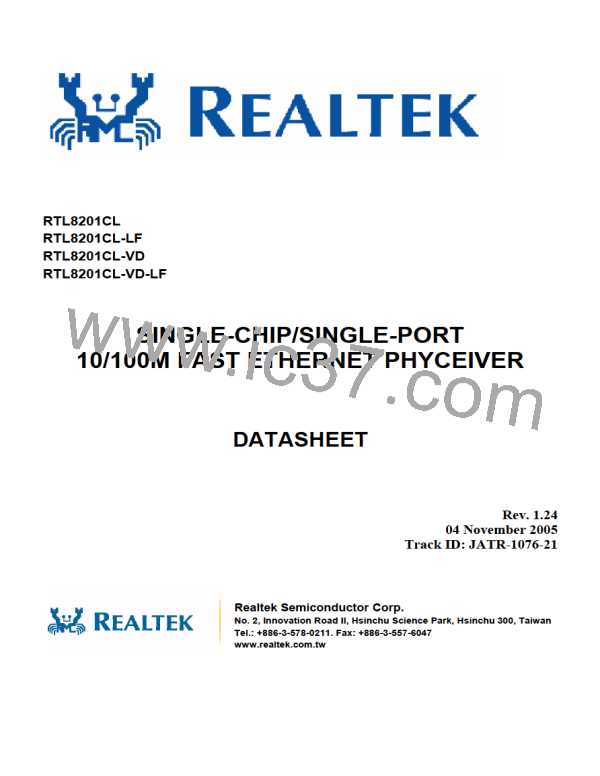RTL8201CL
Datasheet
The transmitter will first assert TXEN. Before transmitting the data pattern, it will send a /J/K/ symbol
(Start-of-frame delimiter), the data symbol, and finally a /T/R/ symbol known as the End-Of-Frame
delimiter. The 4B/5B and the scramble process can be bypassed via a PHY register setting (see Table 1,
page 4, Pin number 24). For better EMI performance, the seed of the scrambler is based on the PHY
address. In a hub/switch environment, each RTL8201CL will have different scrambler seeds and so
spread the output of the MLT-3 signals.
100Base-TX Receive Function
The received signal is compensated by the adaptive equalizer to make up for signal loss due to cable
attenuation and Inter Symbol Interference (ISI). Baseline Wander Correction monitors the process and
dynamically applies corrections to the process of signal equalization. The PLL then recovers the timing
information from the signals and from the receive clock. With this, the received signal is sampled to form
NRZI data. The next steps are the NRZI to NRZ process, unscrambling of the data, serial to parallel and
5B to 4B conversion, and passing of the 4B nibble to the MII interface.
7.8.2. 100Base-FX Fiber Mode Operation
The RTL8201CL can be configured as 100Base-FX via hardware configuration. The hardware
100Base-FX setting takes priority over NWay settings. A scrambler is not required in 100Base-FX.
100Base-FX Transmit Function
Di-bits of TXD are processed as 100Base-TX except without a scrambler before the NRZI stage. Instead
of converting to MLT-3 signals, as in 100Base-TX, the serial data stream is driven out as NRZI PECL
signals, which enter the fiber transceiver in differential-pairs form.
100Base-FX Receive Function
The signal is received through PECL receiver inputs from the fiber transceiver and directly passed to the
clock recovery circuit for data/clock recovery. The scrambler/de-scrambler is bypassed in 100Base-FX.
7.8.3. 10Base-T TX/RX
10Base-T Transmit Function
Transmit data in 4-bit nibbles (TXD[3:0]) clocked at 2.5MHz (TXC) is first fed to a parallel-to-serial
converter, then the 10Mbps NRZ signal is sent to a Manchester encoder. The Manchester encoder
converts the 10Mbps NRZ data into a Manchester Encoded data stream for the TP transmitter and adds a
Start of Idle pulse (SOI) at the end of the packet as specified in IEEE 802.3. Finally, the encoded data
stream is shaped by a bandlimited filter embedded in the RTL8201CL and then transmitted.
10Base-T Receive Function
In 10Base-T receive mode, the Manchester decoder in the RTL8201CL converts the Manchester encoded
data stream into NRZ data by decoding the data and stripping off the SOI pulse. Then the serial NRZ data
stream is converted to a parallel 4-bit nibble signal (RXD[0:3]).
Single-Chip/Port 10/100 Fast Ethernet PHYceiver
21
Track ID: JATR-1076-21 Rev. 1.24

 REALTEK [ Realtek Semiconductor Corp. ]
REALTEK [ Realtek Semiconductor Corp. ]